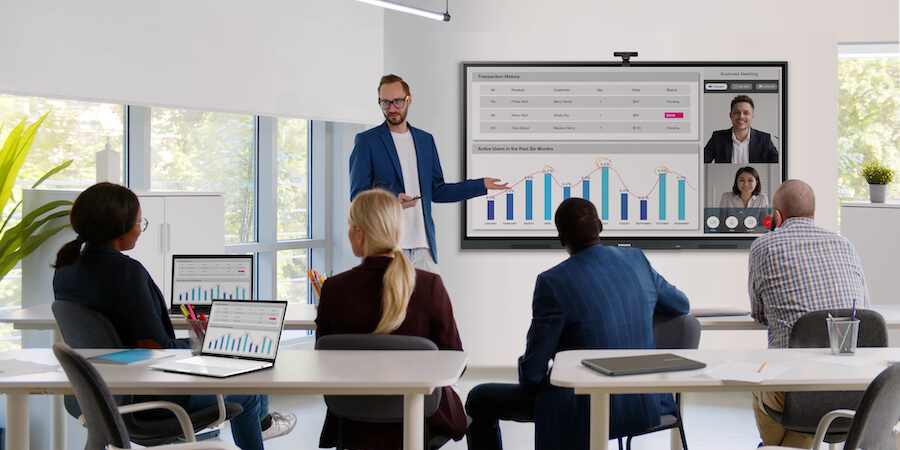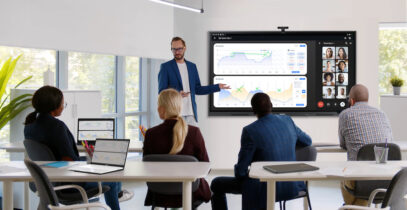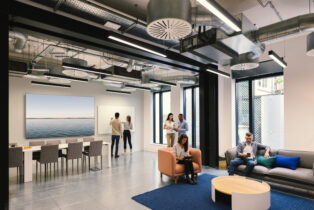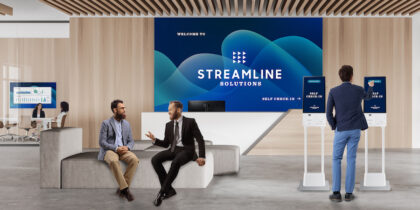Web conferencing technologies — from high-definition (HD) cameras to intuitive software — have enabled companies and organizations to stay connected and productive, even across geographic distances and remote and hybrid work arrangements. This has made display technology all the more relevant and indispensable to enabling rich and fluid collaboration among people and teams, whether they’re in the same room or scattered around the world.
A new class of hypercollaborative displays by Samsung embraces that spirit and elevates its achievement with a palette of features and capabilities that make learning, sharing and collaboration easy and impactful. That includes education, too, as interactive whiteboards, such as the 65- or 75-inch multi-touch Samsung Interactive Displays, have grown increasingly common in the classroom. Here’s why.
More versatile and flexible
Samsung Interactive Displays are changing team capabilities with a wide-growing range of digital tools and features, including these:
- Advanced multi-touch capabilities mean up to 20 people can use the interactive whiteboard at the same time, a time-saving feature for brainstorming sessions.
- In Multiple Screen Mode, Samsung Interactive Display can simultaneously share screens from up to nine connected devices.
- Android 11 OS provides a convenient, intuitive user experience that many users will already be familiar with on their phones and tablets.
- The home screen can be customized to include frequently used apps.
- Via an HDMI cable, content can be shared on a larger screen in an auditorium or large conference room.
- Connectivity is enhanced with the 3-in-1 USB-C port, enabling screen mirroring, touch control and external device charging (max. 65W).
- With the dual pen function, a double-sided nib allows presenters to shift between colors on the front or back side of the pen without interrupting their presentation.
Freedom to do work from anywhere
Amid the ongoing shift to remote and hybrid work and classrooms, advanced communication and display tools are more important than ever. This is particularly important for teams who find themselves working from multiple locations but still needing to visually communicate ideas and plans.
For example, a chief technology officer working from a home office can use a Samsung Interactive Display to mark up the plans for a major IT overhaul and share those on a sister device for colleagues gathered at the main office. Similar scenarios could play out across many working and learning environments, including:
Teaching
Classrooms become more engaging and active when students can get up and use a large screen that everyone can see. As many as 20 people can use a Samsung Interactive Display simultaneously — whether they’re working out math equations, drawing pictures, making lists or marking up images pulled from the internet.
Running Android OS 11, the 75-inch interactive display empowers teachers to use familiar apps with ease. When they are presenting, activity is built and archived around “rolls,” with as many as 20 pages’ or screens’ worth of content saved to a roll. Students working remotely can get the full recaps, including visuals and annotations, effortlessly by email.
Caregiving
A large display with ultra HD resolution allows medical practitioners to review diagnostic imaging together and work out plans as a team. Annotated X-rays or other images can easily be seen, reviewed, revised and sent for opinion to other practitioners in the building — or across the country. They can also share plans with patients and caregivers on a big screen, and then archive those plans on network storage.
Creating
Conventional paper flip charts and marker-based whiteboards limit the creative collaboration process to note-taking and simple drawings. Samsung Interactive Display, on the other hand, offers high-precision multimedia capabilities that enable creative teams to do everything from marking up proofs from graphic designers to creating original designs using the stylus pen and brush tools. Creatives can draw bold oil paint strokes with a pen or create delicate watercolor scenes with a highly sensitive brush.
Teams working with a remote client can operate in near real time on ideas and revisions, making changes on the display and then sending them off instantaneously for feedback. As a result, highly subjective, opinion-driven work that might normally take hours or days can now take minutes — even seconds — for all stakeholders to see, comment and approve.
Versatility for success
The world is no longer as monolithic as it once seemed, and technology is responding accordingly to the greater versatility now required for success. Samsung Interactive Displays take this to heart, optimizing performance and operations for today’s working and learning climate.
Learn more about how to enhance learning with the Samsung Interactive Display and deliver more enriching experiences with blended learning.







